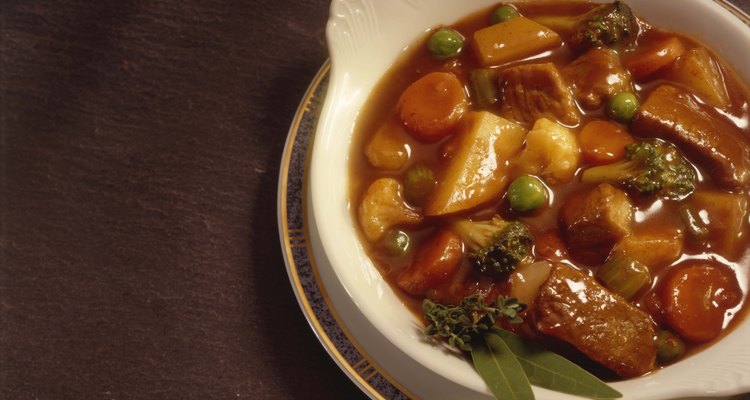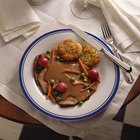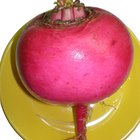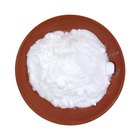
A generic term for smaller pieces of beef, stew meat is typically cut from chuck or round roasts taken from the upper front leg or shoulder area of the cow. With more fat marbling than other cuts, chuck is best suited to stewing or braising, which allows the hot liquid to slowly penetrate and tenderize the fibrous meat. Buying and cutting a whole shoulder roast takes no time at all and can be an economical alternative during spikes in beef prices.
Getting Started
You don't need much equipment to process a beef chuck roast into smaller pieces for stew other than a cutting board, a well-sharpened knife and a container, preferably metal, to hold the meat until you are ready to cook it or store it in the refrigerator or freezer. Unwrap the roast carefully so its juices don't spatter, and place it firmly on the cutting board. Decide how wide you want the stew beef to be and start by cutting a slice of that thickness from one end. Place the slices in the bowl, or if your cutting board is large enough, move them to one end while you work.
Size Determinations
When the whole roast has been sliced, cut each into cubes that are roughly the same length as the thickness of the slice. For example, 1-inch cubes will measure roughly 1 by 1 inch. The smaller the cubes, the less time they will take to cook through; cut any vegetables to about the same size so that all the ingredients in the stew require about the same amount of cooking time.
Getting Creative
The possibilities for using your own freshly cut stew chuck roast meat are nearly endless, and many dishes calling for it are simply variations on basic beef stew. Beef stew itself can be a traditional mix of beef, potatoes, onions and carrots, or you can get creative and incorporate cabbage, turnips, parsnips and even cranberries. Switch out the potatoes for a grain such as barley, or create an Italian dish by incorporating basil and red wine into your basic beef broth. When making basic stew, eliminate having to make a gravy at the end by dusting your beef cubes in seasoned flour and searing them in hot oil before adding any remaining ingredients. Any liquids you add later will thicken slowly during cooking, absorbing the flavors of any seasonings.
Safety First
Raw uncooked meats contain high levels of bacteria that can quickly contaminate all they touch, and these are effectively destroyed only by thorough cooking. Minimize the transference of these bacteria when processing raw beef by working on a cutting board reserved only for meat and disinfecting it as soon as possible when finished. Also disinfect the knife and any container you transfer the meat to while you work, which is easily done by washing them, along with your hands, in lots of hot, soapy water. Wash your hands often as you work with the meat, particularly if you switch to working with other types of foods.
Related Articles

Grinding Your Own Hamburgers With Bacon

How to Cook Meat Cubes in a Slow Cooker

How to Slow-Cook a Pork Roast in a Pot ...

How to Use an Electric Roaster to Slow ...

What Are the Functions of Food ...

How to Freeze Pot Roasts

How to Roast Turnips
Best Crock-Pot Lentil Soup Recipe

How to Shred Brussels Sprouts

How to Cook a Ribeye Roast With Veggies ...

How to Cook Beef Round Cubes on a Pan

How to Make Venison Bratwurst

How Long Can You Cook Beef Ribs at 300 ...
How to Make Beef Bottom Round Roast ...

Complimentary Foods for Beef Bourguignon

How to Cook Beef on a Bun

How to Get Rid of the Acid Taste in ...

How to Cook Corned Silverside in a Slow ...

How to Carve a Bone-In Ribeye

How to Cook Giblets in the Microwave
References
- The Kitchn: Choosing the Best Meat for Beef Stew
- The Cook's Thesaurus: Beef Chuck
- Beef -- It's What's for Dinner: Beef Stew with Cranberries and Roasted Root Vegetables
- FoodSafety.gov: Separate, Don't Cross-Contaminate
- Certified Angus Beef: Chuck Roast
- Certified Angus Beef: Classic Beef Stew
- Cooking Light: Italian Beef Stew
- Cooking Light: Beef, Beer, and Barley Stew
Writer Bio
Rachel Lovejoy has been writing professionally since 1990 and currently writes a weekly column entitled "From the Urban Wilderness" for the Journal Tribune in Biddeford, Maine, as well as short novellas for Amazon Kindle. Lovejoy graduated from the University of Southern Maine in 1996 with a Bachelor of Arts in English.
Photo Credits
Jupiterimages/Stockbyte/Getty Images